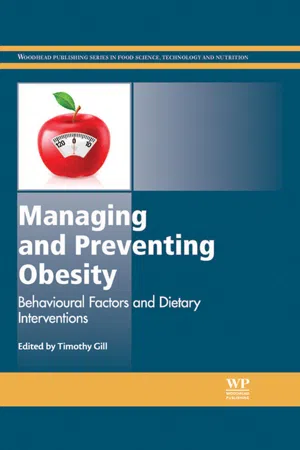
Managing and Preventing Obesity
Behavioural Factors and Dietary Interventions
- 372 pages
- English
- ePUB (mobile friendly)
- Available on iOS & Android
About This Book
Obesity is an increasing problem on a global scale, and strategies for its prevention involve experts from many disciplines including nutritionists, physicians, policy-makers and public health professionals. This book covers the latest advances in obesity development, management and prevention with specific focus on dietary interventions. Part one covers the development of obesity and key drivers for its continuation and increase. Part two looks at the role of specific dietary components in obesity management, and part three discusses the role of behavioural factors such as eating patterns in managing and preventing obesity. Part four focuses on structured dietary interventions for obesity treatment, and part five looks at public interventions and consumer issues.
- Reviews how different foods and diets can affect obesity management
- Examines various ways of preventing and treating obesity
- Explores how governments and industries are preventing and treating obesity
Frequently asked questions
Information
Trends in understanding patterns of obesity and health outcomes
2 World Obesity Federation, London, UK
1.1 Introduction
1.2 The importance of abdominal obesity
Table of contents
- Cover image
- Title page
- Table of Contents
- Copyright page
- List of contributors
- Woodhead Publishing Series in Food Science, Technology and Nutrition
- Preface
- Introduction: an overview of the key drivers of obesity and their influence on diet
- Part One: General issues
- Part Two: The role of different dietary components in obesity management
- Part Three: The role of eating patterns and other behavioural factors in obesity management
- Part Four: Structured dietary interventions in the treatment of obesity
- Part Five: Government and industry interventions in the prevention of obesity
- Index